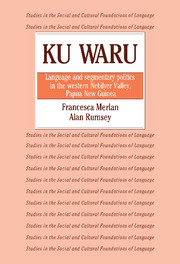Book contents
- Frontmatter
- Contents
- List of illustrations
- List of tables
- List of abbreviations
- Preface and acknowledgments
- 1 Introduction
- 2 The setting
- 3 Some aspects of Ku Waru segmentary sociality
- 4 Ceremonial exchange and marriage in the western Nebilyer Valley
- 5 Some linguistic structures of segmentary politics
- 6 Warfare compensation payment to Laulku: an analysis
- 7 Compensation at Palimung and the Kulka women's club
- 8 The events in perspective
- 9 Perspectives on ‘event’
- Appendix A Transcript of proceedings at Kailge on July 24, 1983
- Appendix B Grammatical sketch of Bo Ung, Ku Waru dialect
- Appendix C The conduct of warfare
- Appendix D Ku Waru metalinguistic expressions
- Chapter notes
- Glossary
- References
- Index
- Plate section
2 - The setting
Published online by Cambridge University Press: 30 December 2009
- Frontmatter
- Contents
- List of illustrations
- List of tables
- List of abbreviations
- Preface and acknowledgments
- 1 Introduction
- 2 The setting
- 3 Some aspects of Ku Waru segmentary sociality
- 4 Ceremonial exchange and marriage in the western Nebilyer Valley
- 5 Some linguistic structures of segmentary politics
- 6 Warfare compensation payment to Laulku: an analysis
- 7 Compensation at Palimung and the Kulka women's club
- 8 The events in perspective
- 9 Perspectives on ‘event’
- Appendix A Transcript of proceedings at Kailge on July 24, 1983
- Appendix B Grammatical sketch of Bo Ung, Ku Waru dialect
- Appendix C The conduct of warfare
- Appendix D Ku Waru metalinguistic expressions
- Chapter notes
- Glossary
- References
- Index
- Plate section
Summary
LOCATION, GEOGRAPHY AND REGIONAL POPULATIONS
Our field site at Kailge lies in the western Nebilyer Valley, on the eastern slopes of the Tambul Range (see Map 1). Varying in elevation from 1500 to 1900m, the Kailge area is frost-free and suitable for cultivation of a wide variety of staples and specialty foods: many varieties of sweet potato; bananas, cane, greens, maize, pandanus, peanuts, beans and winged beans, and taro. Tobacco is cultivated, usually in small mixed-vegetable or other plots near homesteads. Introduced specialty foods which are grown to a limited extent include tomatoes, carrots and cabbage. The higher locations across the Tambul Range to the west, though disadvantageous in their being subject to periodic frosts, are known to be more suited to cultivation of cabbage and European potatoes. Coffee, which grows well throughout the Nebilyer Valley, was introduced as a cash crop from the mid–1960s. The Tambul-side people with whom residents of Kailge have many close social ties cannot raise coffee at their higher elevations, a factor which appears to be related to notable imbalance between the two areas in women's marital destinations – that is, that more Tambul women marry into the Nebilyer than Nebilyer women do into Tambul (see section 4.2).
The Nebilyer Valley (see Maps 1 and 2) is bisected by the Nebilyer [Napilya] River, which rises on the south slopes of Mt Hagen and flows southwards, joining the Kaugel River at the Southern Highlands border (i.e. the old border between New Guinea and Papua). Until recently, the Nebilyer River was a formidable natural barrier which people crossed east of the Kailge area (in Kulka territory) over vine bridges, to which access could easily be restricted.
- Type
- Chapter
- Information
- Ku WaruLanguage and Segmentary Politics in the Western Nebilyer Valley, Papua New Guinea, pp. 20 - 33Publisher: Cambridge University PressPrint publication year: 1991

